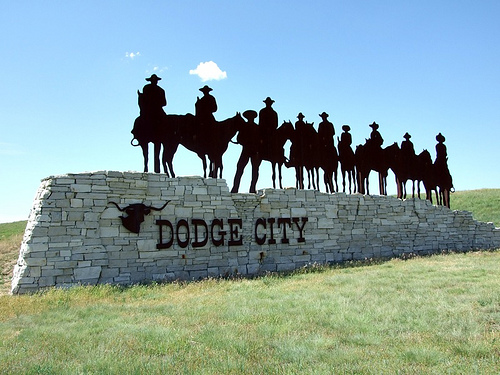Were you the kind of teenager who drummed your fingers on Saturday night and complained that “There’s nothing to do around here”? Or, “I wanna bust out of this Nowheresville!”?
Maybe not. If you check in at this blog with any regularity, you’re probably an avid reader. We readers long for a boring Saturday night, when everybody leaves us alone and we can get lost in Camelot or Nova Scotia or wherever.
But for those who think boredom kills, maybe they would prefer to live in Dodge City sometime after the Civil War. They never ran short on excitement back then. You can get a taste of the action in Mary Doria Russell’s Doc, a fictionalized portrait of the famous Doc Holliday.
Before we get to him, let’s review Dodge City’s place in the world.
Texas was cattle country. Chicago was where cattle turned into steak. Getting the cows from the range to the slaughterhouse required walking them to the nearest train stop. That would be Dodge City.
The drovers who herded them into town had just survived a none-too-comfortable trip. Your average cowboy:
“could be trampled in a stampede or get himself gored by a cranky longhorn. He could be rolled by a spooked horse or break his neck falling off one. He could get snakebit. He could drown crossing a river. He could die of ptomaine poisoning or bloody flux. A cut could go bad. Sometimes that’s all it took.
“Once they got their herd to town, drovers collected their accumulated pay and it was ‘Whoop it up, Liza Jane!’ After three months of relentless labor—enduring bad weather and worse food, sleeping in their clothes, unsheltered on the ground—when they thundered into Wichita or Abilene or Ellsworth, Wyatt [yes, the famous Wyatt Earp. We’ll get to him in a minute.] guessed that those Texas boys could be forgiven for presuming that such places existed for no other reason than to show them a good time.”
Gunfights broke out as regularly as sibling squabbles on a car trip. So, nope, not a boring place.
In Doria Russell’s book, you meet characters may have heard about like Bat Masterson and Eddie Foy. There are mayors and moguls, Chinamen and free blacks, even notable horses that certain characters covet. They can’t afford the horse, of course, but maybe, if a card game goes just right . . .
That’s the Dodge way of doing things.
I could’ve used a few peeks at the author’s cast list as I read. The abundance of marshals and sheriffs alone tested my sanity.
Of course, the most famous Dodgers were Wyatt Earp (along with his many brothers) and, yes, Doc Holliday.
Doc was born to impoverished gentility in Georgia. He contracted tuberculosis early. Hoping the drier Texas air might cure what ailed him, he headed west and set up as a dentist. Sadly, out on the frontier, cowpokes ignored their teeth, unless the toothache got really bad.
Following the action, he ended up in Dodge City, where all the Doc scenes in Doria Russell’s book show the man talkin’ in his gentle Georgia accent, coughin’, playin’ card games (more money in that than dentistry), and breakin’ up/makin’ up with the shady woman in his life.
She is not the only woman that wanted him, in spite of that wrenching cough of his.
Dodge had its heyday of movers and shakers before becoming the kind of small town where teenagers drum their fingers on a Saturday night and complain that “There’s nothing to do around here.” Doria Russell’s book portrays the glory days of a town that, for all its dust and desperation, fixed itself in the American imagination.
Photo credit: josephleenovak on VisualHunt.com / CC BY







Leave A Comment